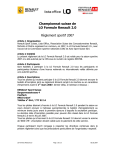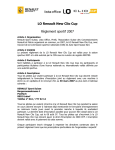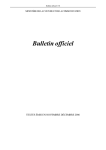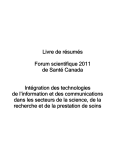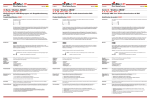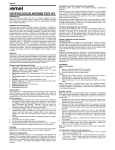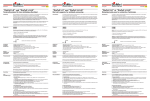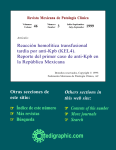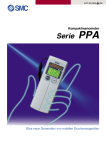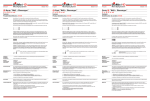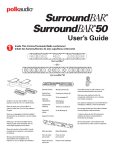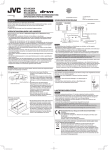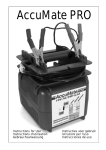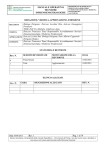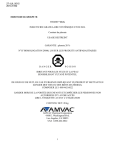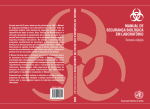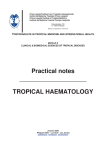Download Seraclone® Anti
Transcript
[UK] ® Seraclone Anti-k (KEL2) For the detection of red blood cell characteristic k Tradeform [REF] [PRES] [ACT] 808 126 Preservative: 0.1 % NaN3 Activity / Min. titer 2 ml Quality control The reactivity of all blood typing reagents should be confirmed on each day of use. To confirm the reactivity or specificity of Bio-Rad monoclonal Seraclone® Anti-k (KEL2) Blood Grouping Reagent should be tested with antigen-positive (preferably from heterozygous individuals) and antigen-negative red blood cells. The reagent is acceptable for use if it reacts only with antigen-positive red blood cells. Performance characteristics and limitations of the method • • [IVD] Diagnostic reagent for in vitro use only To be used by trained laboratory personnel only. The [ACT] is printed on the label. Symbols are used according to standard DIN EN 980. Symbols not contained in standard DIN EN 980 are described. Intended use Seraclone® Anti-k (KEL2) is used for the determination of the k (Cellano) antigen of red blood cells using the tube test. • • • Summary Kell-System Since the description of the antigen K in 1946 by Coombs et al and its allele k in 1949 by Levine et al, the Kell blood group system has been shown to be increasingly complex and over 20 antigens are now known to be associated with the system. These are probably controlled from a series of closely linked loci so that Kell antigens, like CDE in the Rh system, are inherited as haplotype. The antigens of the Kell blood group system are of further interest in that they tend to occur either very frequently or relatively infrequently and show considerable ethnic variation (e.g. k (KEL2): Caucasians 99.8%, Blacks 100%)2 and K (KEL1): Caucasians 9%, Blacks 2 %, Asians rare, Arabs as high as 25%)2). Kell system antibodies are capable of causing hemolytic transfusion reactions and hemolytic disease of the newborn. Test principle The test principle is a hemagglutination test to detect the respective red cell antigens. Red cells from individuals of the Kell phenotype Kk, Kp (a+b+) show a substantially weakened expression of the k antigen. The Kell and Cellano antigenicity can be weakened in case of antigen variants which occur rarely, for example the McLeod syndrome. The McLeod syndrome is associated with the McLeod phenotype, whereby the Kell antigens are slightly expressed and Km (KEL20) and Kx are missing.1Excessive agitation may disrupt weak agglutination and produce false negative results. In case of ambiguous results it is recommended to wash red blood cells at least 2 times. Stored red blood cells may exhibit weaker reactions. Some conditions that may cause false results are: - Contamination of sample or reagent, - Improper storage or preparation of red blood cells - Autoantibodies - Antibodies to antibiotics - Cold antibodies - Positive Direct Anti-Globulin Test - Strongly lipemic or icteric samples In case of questionable results of unknown origin our Bio-Rad Service will assist you (phone: +49-6103-3130-611). Shelf life Storage temperature of Seraclone Anti-k (KEL2) is 2…8°C. After opening the reagent the product can be stored until its expiry date under proper storage conditions. The expiry date is printed on the label. The blood type k is defined by presence or absence of the k characteristic on red cells. The antigen k reacts specifically with the corresponding antibody in Seraclone® Anti-k (KEL2) by direct agglutination. The reagent is used in tube testing. Warning and precautions Reagent • As reactive component Seraclone® Anti-k (KEL2) contains a murine monoclonal antibody of the immunoglobulin class IgM which is derived from hybridoma cell lines created by fusing mouse antibody producing B lymphocytes with mouse myeloma cells and demonstrate consistent specificity and reproducibility characteristic for monoclonal antibodies. Antibodies are diluted in citrate buffer pH 5.2 to 5.3 with bovine albumin and macromolecular potentiators. Seraclone® Anti-k (KEL2) clone Lk1 Materials required but not provided • • • • Pipettes (volume 50 μl) Phosphate Buffered Saline (PBS) pH 7.3 ± 0.2 or isotonic saline Glass tubes Laboratory centrifuge Specimen collection Fresh samples of clotted, EDTA or citrate anticoagulated whole blood collected following general blood sampling guidelines are acceptable. The specimen should be tested as soon as possible after collection. If testing is delayed, specimens should be stored at 2 to 8°C. Blood specimens exhibiting gross hemolysis or contamination should not be used. Clotted samples or those collected in EDTA may be tested within 14 days from collection. Donor blood stored in citrate anticoagulant may be tested until the expiration date of the donor unit. Test procedure 1. 2. 3. 4. 5. 6. Prepare a 3 to 5% suspension of red blood cells to be tested in saline or PBS. Place one drop (approximately 50 µl) reagent into an appropriately labelled tube. Add one drop (approximately 50 µl) of red blood cell suspension into the tube and mix. Incubate for 5 to 10 minutes at room temperature. Centrifuge for : a. 20 seconds at 800 to 1000 x g or b. at a time and speed appropriate for the centrifuge calibration. Gently dislodge the red blood cell button and observe for macroscopic agglutination. Interpretation of results Evaluation of the reaction strength should be carried out according to the Technical Manual1 Reaction strength 4+ 3+ 2+ 1+ +/- Agglutination One single agglutinate Several large agglutinates. Medium-size agglutinates, clear background. Small agglutinates, turbid background Barely visible agglutination, turbid background No agglutination Stability of the reaction Following centrifugation, all tube tests should be read immediately and results interpreted without delay. Time delays may cause a dissociation of the antigenantibody complexes resulting to false negative or more often weak positive reactions. • • • • • • Do not use damaged vials Turbidity or other visible changes may indicate bacterial contamination. Do not use if turbid. All handling techniques are to be performed according to the manufacturer’s instructions. Each deviation from these instructions is the sole responsibility of the user and needs to be validated by the user. Used tests must be discarded as hazardous material. Waste information is provided in the safety data sheet. Because of biotechnological manufacturing of monoclonal antibodies the risk of contamination with infectious agents can be considered as insignificant. Nevertheless, all test reagents must be regarded as potential infectious. Appropriate safety precautions are recommended. The packaging of this product contains natural rubber latex which may cause allergic reactions. The product contains sodium azide (NaN3), which may react with lead or copper plumbing to form explosive azides. If discarded in the sink, flush with large amounts of water to prevent the build-up of explosive metal azides. References (1) Technical Manual, 17th edition, Section 1, American Association of Blood Banks (2) The Blood Group Antigen Facts Book, 3rd edition, Marion Reid, Christine LomasFrancis and Martin L. Olsson Key: Underline = Addition or significant change ◄= Deletion of text Seraclone® Anti-k (KEL2) [DE] Zum Nachweis des erythrozytären Antigens k Handelsform [REF] 808 126 2 ml [PRES] Konserviert mit: 0,1 % NaN3 [ACT] Aktivität / Mindesttiter [IVD] Reagenz zur In-vitro-Diagnostik Nur für die Verwendung durch geschultes Laborpersonal. Der [ACT] ist dem Etikett zu entnehmen. Symbole werden entsprechend der Norm DIN EN 980 verwendet. In DIN EN 980 nicht enthaltene Symbole sind im weiteren Text erklärt. Verwendungszweck Seraclone® Anti-k (KEL2) wird zum Nachweis des Blutgruppenmerkmals k (Cellano) in der Röhrchen Testmethode eingesetzt. Überblick Kell-System Seit der Beschreibung des Antigens K in 1946 durch Coombs et al. und seiner k Allele in 1949 durch Levine et al. zeigte sich, dass das Kell-Blutgruppensystem sehr komplex ist und mittlerweile mehr als 20 mit dem Kell -System assoziierte Antigene bekannt sind. Diese werden wahrscheinlich von einer Reihe eng verbundener Genloci kontrolliert, die wie beim CDE des Rhesussystems als Haplotypen vererbt werden. Die Antigene des Kell-Systems sind weiterhin von Interesse, da sie dazu tendieren entweder sehr häufig oder relativ selten aufzutreten und sie zeigen erhebliche ethnische Variationen (z.B. k (KEL2): Kaukasier 99,8%, Schwarze 100%) und K (KEL1) Kaukasier, 9%, Schwarze 2%, Asiaten selten, Araber etwa 25%2. Zur vollständigen Expression der Antigene werden Disulfidbrücken gebildet, die durch die Behandlung mit Trypsin und Chymotrypsin zerstört werden. | 186985/01 – 01/2015 Antikörper des Kell-Systems können hämolytische Transfusionsreaktionen und Morbus haemolyticus neonatorum auslösen. Testprinzip Das Testprinzip ist ein Hämagglutinationstest zum Nachweis des entsprechenden Erythrozyten-Antigens. Die Blutgruppe k wird durch das Vorhandensein oder Fehlen des Merkmals k auf den Erythrozyten definiert. Das Antigen k reagiert spezifisch mit dem korrespondierenden Antikörper in Seraclone® Anti-k (KEL2) durch direkte Agglutination. Das Reagenz wird in der Röhrchen Testmethode eingesetzt. Reagenz Seraclone® Anti-k (KEL2) enthält als reaktiven Bestandteil einen murinen monoklonalen Antikörper der Immunglobulinklasse IgM. Er wird aus dem ZellkulturÜberstand gewonnen und weist die für monoklonale Antikörper geltende konstante Spezifität und Reproduzierbarkeit auf. Die Antikörper sind in einem rinderalbuminhaltigen mit makromolekularen Verstärkern versetzten Citrat Puffer pH 5.2 bis 5.3 verdünnt. Seraclone® Anti-k (KEL2) Warnhinweis und Vorsichtsmaßreglen • • • • • • • Klon Lk1 Zusätzlich benötigte Materialien • • • • Pipetten (Volumen 50 μl) Phosphate Buffered Saline (PBS) pH 7,3 ±0,2 oder physiologische Kochsalzlösung Glasröhrchen Laborzentrifuge Probenmaterial Die Verwendung frischer Nativ-, EDTA- oder Citrat-Vollblutproben, gewonnen nach den allgemein gültigen Entnahmeverfahren, ist zulässig. Die Blutproben sollten schnellstmöglich nach der Entnahme getestet werden. Verzögert sich die Testdurchführung sollten die Proben bei 2…8°C gelagert werden. Hämolytische oder kontaminierte Blutproben sollten nicht verwendet werden. Nativblute und EDTA-Blute sollten innerhalb 14 Tagen nach Abnahme getestet werden. Citratproben von Spendern können bis zum Verfallsdatum der Konserve verwendet werden. Testdurchführung 1. 2. 3. 4. 5. 6. Eine 3-5%ige Erythrozytensuspension in Kochsalz oder PBS erstellen. 1 Tropfen (ca. 50µl) Reagenz in ein entsprechend beschriftetes Röhrchen vorlegen. 1 Tropfen (ca. 50µl) Erythrozytensuspension dazugeben und mischen. 5 bis 10 Minuten bei Raumtemperatur inkubieren. Zentrifugieren: a. 20 Sekunden bei 800 - 1000 x g oder b. bei einer Zeit und Geschwindigkeit, die der Zentrifugen-Kallibrierung entspricht. Unter leichtem Aufschütteln auf makroskopische Agglutination prüfen. Interpretation der Ergebnisse: Die Bewertung der Reaktionsstärken erfolgt analog den Vorgaben des Technical Manual (1): Reaktionsstärke Agglutinationsbild 4+ Ein einziges Agglutinat. 3+ Mehrere große Agglutinate. 2+ Mittelgroße Agglutinate, klarer Hintergrund. 1+ Kleine Agglutinate, trüber Hintergrund. +/Gerade noch sichtbare Agglutinate, trüber Hintergrund. Keine Agglutinate. Qualitätskontrolle Die Reaktivität aller Blutgruppenreagenzien sollte an jedem Tag der Verwendung überprüft werden. Um die Reaktivität und Spezifität von Seraclone® Anti-k (KEL2) zu bestätigen, sollte mit Antigen positiven (vorzugsweise von heterozygoten Zellen) und Antigen negativen Erythrozyten getestet werden. Das Reagenz ist für den Gebrauch geeignet, wenn es nur mit den Antigen positiven Erythrozyten reagiert. Leistungsmerkmale und Grenzen der Methode • Erythrozyten vom Phenotyp Kk, Kp(a+b+) zeigen eine abgeschwächte Expression des k Antigens. • Die Kell- und Cellano-Antigenität kann im Fall von selten vorkommenden Antigenvarianten, wie z.B. beim McLeod Syndrom abgeschwächt sein. Das McLeod Syndrom ist assoziiert mit dem McLeod Phänotyp, wobei die KellAntigene schwach exprimiert sind und Km (KEL20) ebenso wie Kx fehlen. • Zu starkes Aufschütteln kann im Falle von schwachen Agglutinaten zu falsch negativen Ergebnissen führen. • Bei unklaren Ergebnissen wird empfohlen die Erythrozyten 2 mal zu waschen. • Aufbewahrte Erythrozyten können schwächere Reaktionen zeigen. • Mögliche Ursachen für ein falsches Ergebnis: Kontamination der Probe oder des verwendeten Reagenzes Unzureichende Lagerung oder Vorbereitung der Erythrozyten Autoantikörper Antikörper gegen Antibiotika Kälteantikörper Positiver Direkter Anti-Globulin Test Stark lipämische oder ikterische Proben Bei zweifelhaften Ergebnissen unklarer Ursache steht der Bio-Rad-Service (Tel. 06103–3130-611) für Rückfragen zur Verfügung. Haltbarkeit Die Lagerungstemperatur von Seraclone® Anti-k (KEL2) ist 2…8°C. Nach Öffnung des Reagenzes ist das Produkt bei sachgemäßer Lagerung bis zum Ende der angegebenen Laufzeit haltbar. Die Laufzeit ist dem Reagenzienetikett zu entnehmen. MBio-Rad Medical Diagnostics GmbH Industriestr. 1, D-63303 Dreieich, Germany Tel.: +49-6103-3130-0, Fax: +49-6103-3130-724 www.bio-rad.com, [email protected] Beschädigte Fläschchen dürfen nicht mehr verwendet werden. Eine Trübung des Produktes kann ein Hinweis auf bakterielle Verunreinigung sein. In diesem Fall darf das Produkt nicht eingesetzt werden. Alle Techniken sind nach den Vorgaben des Herstellers anzuwenden. Jede Abweichung von den Vorgaben des Herstellers liegt in der Verantwortung des Anwenders und muss von diesem validiert werden. Gebrauchtes Testmaterial muss als Gefahrgut betrachtet werden. Hinweise zur Entsorgung sind dem Sicherheitsdatenblatt zu entnehmen. Durch die biotechnologische Herstellung der monoklonalen Antikörper ist das Risiko einer Kontamination durch infektiöse Krankheitserreger nahezu ausgeschlossen. Trotzdem sollten alle Testreagenzien als potentiell infektiös gehandhabt und die entsprechenden Sicherheitsvorkehrungen getroffen werden. Die Verpackung dieses Produktes enthält natürliches Latex welches allergische Reaktionen auslösen kann. Das Produkt enthält Natriumazid (NaN3), welches mit Blei- oder Kupferrohren zu explosiven Aziden reagieren kann. Bei einer Entsorgung im Abfluss mit viel Wasser nachspülen, um die explosive Verbindung von Metallaziden zu verhindern. Literatur (1) Technical Manual, 17th edition, Section 1, American Association of Blood Banks (2) The Blood Group Antigen Facts Book, 3rd edition, Marion Reid, Christine LomasFrancis and Martin L. Olsson Schlüssel: Unterstrichen = Zusatz oder wichtige Änderung ◄= Entfernter Text [FR] Seraclone® Anti-k (KEL2) Pour la détection de l’antigène érythrocytaire k Présentation 808 126 2 ml [REF] [PRES] Conservé avec : 0,1 % NaN3 [ACT] Activité / Titre minimum [IVD] Réactif de diagnostic in vitro Peut uniquement être utilisé par un personnel qualifié. L’[ACT] figure sur l’étiquette. Les symboles utilisés sont conformes à la norme DIN EN 980. Les symboles non prévus par la norme DIN EN 980 seront expliqués dans le texte. Usage Seraclone® Anti-k (KEL2) est utilisé dans la méthode d’essai en éprouvettes pour détecter le marqueur du groupe sanguin k (cellano). Aperçu du système Kell Depuis la description de l’antigène k par Coombs et al. en 1946 et de son allèle k par Levine et al. en 1949, le système de groupes sanguins Kell a révélé son extrême complexité et plus de 20 antigènes associés au système Kell sont désormais connus. Ceux-ci sont probablement contrôlés par une série de loci génétiques étroitement liés qui, comme le CDE du système rhésus, sont transmis sous forme d’haplotypes. Les antigènes du système Kell sont très intéressants puisqu’ils ont tendance à apparaître soit très fréquemment, soit relativement rarement et ils révèlent des variations ethniques substantielles (par exemple k (KEL2) : Caucasiens 99,8 %, Noirs 100 %2 et K (KEL1) : Caucasiens, 9 %, Noirs 2 %, Asiatiques rarement, Arabes près de 25 %)2. Pour exprimer entièrement les antigènes, des ponts disulfures se forment et seront détruits par un traitement par trypsine et chymotrypsine. Les anticorps du système Kell peuvent déclencher des réactions transfusionnelles hémolytiques et la maladie hémolytique du nouveau-né. Principe du test Le principe du test consiste dans un test d’hémagglutination pour détecter l’antigène érythrocytaire. Le groupe sanguin k se définit par la présence ou l’absence du marqueur k sur les érythrocytes. L’antigène k réagit de manière spécifique avec l’anticorps correspondant dans Seraclone® Anti-k (KEL2) par une agglutination directe. Le réactif est utilisé dans la méthode d’essai en éprouvettes. Réactif Le réactif de Seraclone® Anti-k (KEL2) contient un anticorps monoclonal murin de la classe d’immunoglobulines IgM provenant d’un hybridome issu de la fusion de lymphocytes B et de myélomes de cellules de souris dont les anticorps présentent une constante reproductibilité et spécificité. Les anticorps sont dilués dans un tampon citrate de pH 5,2 à 5,3 contenant de l’albumine de sérum bovin et des potentiateurs macromoléculaires. Seraclone® Anti-k (KEL2) clône Lk1 Matériel nécessaire non fourni • • • • Pipettes (volume 50 μl) Tampon phosphate salin (PBS) pH 7,3 ±0,2 ou Solution saline isotonique Éprouvettes en verre Centrifugeuse de laboratoire Échantillons Il est possible d’utiliser des échantillons de sang frais total natif, EDTA ou citraté provenant des procédés de prélèvement courants. Les échantillons de sang doivent être testés le plus rapidement possible après le prélèvement. Si la réalisation de l’essai est retardée, les échantillons doivent être conservés entre 2…8°C. Il convient de ne pas utiliser les échantillons de sang hémolysés ou contaminés. Le sang natif et le sang EDTA doivent être testés dans un délai de 14 jours à compter du prélèvement. Les échantillons citratés peuvent être utilisés jusqu’à la date d’expiration de la poche de sang. | 186985/01 – 01/2015 Mode opératoire 1. 1. 2. 3. 4. 5. Faire une suspension d’érythrocytes à 3-5 % dans une solution saline ou PBS. Mettre 1 goutte (environ 50µl) de réactif dans une éprouvette étiquetée. Rajouter 1 goutte (environ 50µl) de suspension d’érythrocytes et mélanger. Laisser incuber 5 à 10 minutes à température ambiante. Centrifuger: a. 20 secondes pour 800 - 1000 x g ou b. pour une durée et à une vitesse correspondant au calibrage de la centrifugeuse. Agiter doucement et vérifier la présence d’agglutinations macroscopiques. Interprétation des résultats La force de réaction est évaluée conformément aux consignes du manuel technique Technical Manual (1): Force de réaction Agglutination 4+ Une seule agglutination. 3+ Plusieurs grosses agglutinations. 2+ Agglutinations moyennes, fond clair. 1+ Petites agglutinations, fond trouble. +/Agglutinations à peine visibles, fond trouble. Pas d’agglutination. Stabilité de la réaction Après centrifugation, toutes les éprouvettes doivent être lues et interprétées immédiatement sans délai. Tout délai peut entraîner une dissociation du complexe antigène-anticorps entraînant des réactions faussement négatives ou plus souvent des réactions faiblement positives. Contrôle de qualité Il convient d’examiner la réactivité de tous les réactifs pour la détermination du groupe sanguin le jour de leur utilisation. Pour confirmer la réactivité et la spécificité de Seraclone® Anti-k (KEL2), il convient d’effectuer des essais avec des érythrocytes à antigènes positifs (de préférence de cellules hétérozygotes) et des érythrocytes à antigènes négatifs. Le réactif peut être utilisé s’il réagit uniquement aux érythrocytes à antigènes positifs Caractéristiques et limites de la méthode • • • • • • Les érythrocytes du phénotype Kk, Kp(a+b+) montrent une expression affaiblie de l’antigène k. L’antigénicité Kell et Cellano peut être affaiblie dans les très rares cas de variations antigéniques, tels que le syndrome de McLeod. Le syndrome de McLeod est associé au phénotype de McLeod, caractérisé par une expression affaiblie des antigènes Kell et l’absence des antigènes Km (KEL20) et Kx. Une agitation trop vigoureuse peut fausser négativement les résultats en cas d’agglutinations faibles. Si les résultats sont ambigus, il est recommandé de laver deux fois les érythrocytes. Les érythrocytes conservés peuvent montrer des réactions plus faibles. Causes possibles de résultats faussés : Contamination de l’échantillon ou du réactif utilisé Stockage ou préparation impropre des érythrocytes Auto-anticorps Anticorps contre les antibiotiques Anticorps froids Test direct à l’antiglobuline positif Échantillons très lipémiques ou ictériques Si la cause des résultats douteux n’est pas claire, il convient de contacter le service Bio-Rad (tél. +49-6103-3130-611). Durée de conservation Seraclone® Anti-k (KEL2) doit être conservé entre 2…8°C. Après ouverture du réactif, le produit conservé dans des conditions adéquates se conserve jusqu’au terme de la durée indiquée. La durée figure sur l’étiquette du réactif. Avertissement et précautions • • • • • • • Ne pas utiliser d’éprouvettes endommagées. La turbidité du produit peut indiquer une contamination bactérienne. Dans ce cas, ne pas utiliser le produit. Toutes les techniques doivent être utilisées conformément aux instructions du fabricant. Le non-respect des instructions du fabricant relève de la responsabilité de l’utilisateur qui devra le valider. Le matériel d’essai usagé doit être considéré comme matière dangereuse. Les consignes relatives à l’élimination des déchets figurent sur la fiche de données de sécurité. En raison de la préparation biotechnologique des anticorps monoclonaux, le risque de contamination par des agents infectieux est quasiment exclu. Toutefois, tous les réactifs des essais doivent être manipulés comme étant potentiellement infectieux. Il est recommandé de prendre les précautions de sécurité qui s’imposent. L’emballage de ce produit contient du latex naturel qui peut déclencher des réactions allergiques. Le produit contient de l’azoture de sodium (NaN3) qui peut réagir avec la tuyauterie en plomb ou en cuivre pour former des azotures explosifs. En cas de rejet dans les conduits d’évacuation, rincer à grande eau pour éviter la formation d’azotures métalliques explosifs. Bibliographie (1) Technical Manual, 17th edition, Section 1, American Association of Blood Banks (2) The Blood Group Antigen Facts Book, 3rd edition, Marion Reid, Christine LomasFrancis and Martin L. Olsson Clé : Souligné = complément ou modification importante ◄= texte supprimé MBio-Rad Medical Diagnostics GmbH Industriestr. 1, D-63303 Dreieich, Germany Tel.: +49-6103-3130-0, Fax: +49-6103-3130-724 www.bio-rad.com, [email protected] [IT] ® Seraclone Anti-k (KEL2) Per la rilevazione dell’antigene eritrocitario k Forma commerciale 808 126 2 ml [RIF] [PRES] Conservato con: 0,1 % NaN3 [ACT] Attività / Titolo minimo [IVD] Reagente per diagnostica in vitro Solo per l’utilizzo da parte di personale di laboratorio addestrato. Per l’[ACT] far riferimento all’etichetta. I simboli vengono utilizzati ai sensi della norma DIN EN 980. I simboli non contenuti nella DIN EN 980 sono descritti nel testo. Uso previsto Il Seraclone® Anti-k (KEL2) viene impiegato per la rilevazione della caratteristica del gruppo sanguigno k (Cellano) col metodo in provetta. Cenni sul sistema Kell Sin dalla descrizione dell’antigene k nel 1946 da parte di Coombs et al. e del suo Allele k nel 1949 di Levine et al., il sistema del gruppo sanguigno Kell si è dimostrato molto complesso: attualmente sono oltre 20 gli antigeni associati al sistema Kell. Questi vengono probabilmente controllati da una serie di loci strettamente collegati così che gli antigeni Kell, come per CDE del sistema Rhesus, vengono ereditati come aplotipi. Gli antigeni del sistema Kell sono di ulteriore interesse in quanto tendono a comparire sia molto spesso che piuttosto raramente e mostrano variazioni etniche rilevanti (es. k (KEL2): caucasici 99,8%, neri 100%) e K (KEL1) caucasici 9%, neri 2%, asiatici di rado, arabi circa 25%2. Per l’espressione completa degli antigeni vengono formati ponti disolfuro, distrutti nel trattamento con tripsina e chimotripsina. Gli anticorpi del sistema Kell sono in grado di causare reazioni trasfusionali emolitiche e la malattia emolitica del neonato. Principio del test Il test si basa sul principio di emoagglutinazione per rilevare il rispettivo antigene eritrocitario. Il gruppo sanguigno k è definito dalla presenza o assenza della caratteristica k sugli eritrociti. L’antigene k reagisce in modo specifico con l’anticorpo corrispondente nel Seraclone® Anti-k (KEL2) tramite agglutinazione diretta. Il reagente viene utilizzato col metodo in provetta. Reagente Seraclone® Anti-k (KEL2) contiene come componente reattiva un anticorpo monoclonale murino di classe immunoglobulinica IgM, che deriva da linee di coltura cellulare e dimostra la specificità e la riproducibilità costanti, caratteristiche degli anticorpi monoclonali. Gli anticorpi sono diluiti in tampone citrato con pH 5.2-5.3 con albumina bovina e potenziatori macromolecolari. Seraclone® Anti-k (KEL2) Clone Lk1 Ulteriori materiali richiesti • • • • Pipette (volume 50 μl) Tampone fosfato salino (PBS) pH 7,3 ± 0,2 o soluzione fisiologica Provette di vetro Centrifuga da laboratorio Raccolta di campioni È ammesso l’utilizzo di campioni freschi di sangue nativo o raccolto in EDTA o citratato, ottenuto secondo le procedure di raccolta generalmente valide. I campioni devono essere testati appena possibile dopo la raccolta. Se l’esecuzione del test viene ritardata, i campioni devono essere conservati a 2…8 °C. Non utilizzare campioni di sangue emolitici o contaminati. I campioni di sangue coagulato o raccolto in EDTA possono essere testati entro 14 giorni. I campioni di sangue con citratato di donatori possono essere testati fino alla data di scadenza della sacca. Esecuzione del test 1. 2. 3. 4. 5. 6. Preparare una sospensione di eritrociti al 3-5% in soluzione salina o PBS. Inserire 1 goccia (ca. 50µl) di reagente in una provetta etichettata. Aggiungere 1 goccia (ca. 50µl) di sospensione di eritrociti e miscelare. Incubare per 5-10 minuti a temperatura ambiente. Centrifugare: a. 20 secondi a 800 - 1000 x g oppure b. per un tempo e ad una velocità che corrispondono alla calibrazione della centrifuga. Scuotere leggermente per verificare l’agglutinazione macroscopica. Interpretazione dei risultati La valutazione delle forze di reazione avviene secondo le indicazioni del Technical Manual (1): Forza di reazione Agglutinazione 4+ Agglutinato singolo. 3+ Diversi grandi agglutinati. 2+ Agglutinati medi, sfondo chiaro. 1+ Agglutinati piccoli, sfondo torbido. +/Agglutinati appena visibili, sfondo torbido. Nessun agglutinato. Stabilità della reazione Dopo la centrifugazione, tutte le provette devono essere lette immediatamente e i risultati interpretati subito. Ritardi nella lettura potrebbero causare una dissocaizione dei complessi antigene-anticorpo portando a risultati falso-negativi o più spesso a reazioni debolmente positive. | 186985/01 – 01/2015 Controllo di qualità La reattività di tutti i reagenti dei gruppi sanguigni deve essere verificata ogni giorno di utilizzo. Per confermare la reattività e la specificità di Seraclone® Anti-k (KEL2), il reagente deve essere testato con eritrociti positivi all’antigene(preferibilmente da cellule eterozigoti) e negativi. Il reagente può essere impiegato se reagisce solo con gli eritrociti positivi per l’antigene. Caratteristiche prestazionali e limiti del metodo • Gli eritrociti del fenotipo Kk, Kp(a+b+) mostrano un’espressione indebolita dell’Antigene k. • L’antigenicità di Kell e Cellano può essere indebolita in caso di varianti rare di antigeni, come ad es. la sindrome McLeod. La sindrome McLeod è associata al fenotipo McLeod, per cui gli antigeni Kell sono espressi in modo debole, mentre Km (KEL20) e Kx mancano. • Un’agitazione troppo forte può portare a risultati negativi errati in caso di agglutinati deboli. • In caso di risultati non chiari si consiglia di lavare 2 volte gli eritrociti. • Gli eritrociti conservati possono mostrare reazioni più deboli. • Possibili cause di un risultato errato: contaminazione del campione o del reagente utilizzato conservazione o preparazione degli eritrociti non corrette autoanticorpi anticorpi contro gli antibiotici anticorpi freddi test antiglobulina diretto positivo campioni fortemente lipemici o itterici. In caso di risultati dubbi per cause non chiare, è disponibile il servizio Bio-Rad (Tel. +49-6103-3130-611) per chiarimenti. Stabilità ® La temperatura di conservazione di Seraclone Anti-k (KEL2) è 2…8°C. Una volta aperto il reagente, il prodotto può essere utilizzato fino alla scadenza indicata, se conservato in modo appropriato. La scadenza è indicata sull’etichetta del reagente. Avvertenze e precauzioni • • • • • • • Non utilizzare flaconcini danneggiati. L’intorbidimento del prodotto può indicare una contaminazione batterica. Non utilizzare il prodotto torbido. Applicare tutte le tecniche secondo le indicazioni del produttore. Qualsiasi variazione dalle indicazioni del produttore avviene sotto la responsabilità dell’utilizzatore e dovrà essere da questi validata. Il materiale di prova usato deve essere considerato come pericoloso. La scheda di sicurezza contiene le indicazioni per lo smaltimento. Con la produzione biotecnologica di anticorpi monoclonali si esclude quasi del tutto il rischio di una contaminazione tramite agenti infettivi. Ciononostante, tutti i reagenti devono essere considerati come potenzialmente infettivi. Pertanto occorrerà prendere le misure di sicurezza necessarie. La confezione di questo prodotto contiene lattice naturale, che può causare reazioni allergiche. Il prodotto contiene sodio azide (NaN3), che può reagire con tubature di piombo o rame per formare azoturi esplosivi. Per smaltirlo, sciacquare lo scarico con acqua abbondante per evitare il rischio di formazione di azoturi metallici. Bibliografia di riferimento (1) Technical Manual, 17th edition, Section 1, American Association of Blood Banks (2) The Blood Group Antigen Facts Book, 3rd edition, Marion Reid, Christine LomasFrancis and Martin L. Olsson Chiave: Sottolineato = Integrazione o modifica importante ◄= Testo eliminato [ES] ® Seraclone Anti-k (KEL2) Para determinar la presencia del antígeno eritrocitario k Forma comercial [REF] 808 126 [PRES] Conservación: 0,1 % NaN3 [ACT] Actividad / título mínimo 2 ml [IVD] Reactivo para el diagnóstico in vitro Destinado exclusivamente para uso profesional en laboratorio. La actividad/título mínimo [ACT] se indica en la etiqueta. La simbología utilizada corresponde con la norma DIN EN 980. Los símbolos que no se contemplen en la norma DIN EN 980 se explicarán en el texto. Uso previsto Seraclone® Anti k (KEL2) se usa para determinar la característica del grupo sanguíneo k (Celano) mediante método de tubo de ensayo. Los anticuerpos del sistema Kell pueden provocar reacciones hemolíticas a una transfusión y la enfermedad hemolítica neonatal. Principio de ensayo El principio del ensayo consiste en una prueba de hemaglutinación para determinar el antígeno eritrocitario correspondiente. El grupo sanguíneo k se define por la presencia o ausencia del carácter k en los eritrocitos. El antígeno k reacciona específicamente con el correspondiente anticuerpo contenido en Seraclone® Anti k (KEL2) por aglutinación directa. El reactivo se utiliza en la prueba en tubo. Reactivo Seraclone® Anti k (KEL2) contiene como componente reactivo, un anticuerpo monoclonal murino de la clase de inmunoglobulina IgM, el cual es producido por hibridomas creadas de la fusión de linfocitos B productores de anticuerpos con células de mieloma múrino y muestra la especificidad constante y la reproducibilidad características de los anticuerpos monoclonales. Los anticuerpos están diluidos en un buffer de citrato con pH 5.2 a 5.3 que contiene albúmina bovina y potenciadores macromoleculares. Seraclone® Anti k (KEL2) • • • • MBio-Rad Medical Diagnostics GmbH Industriestr. 1, D-63303 Dreieich, Germany Tel.: +49-6103-3130-0, Fax: +49-6103-3130-724 www.bio-rad.com, [email protected] Pipetas (volumen 50 μl) Buffer Salino de Fosfatos (PBS) pH 7,3 ± 0,2 o solución salina isotónica Probeta de vidrio Tubos de laboratorio Muestras Se deben usar muestras frescas de sangre coagulada ó sangre anticoagulada con EDTA ó citrato, colectadas siguiendo las guías generales de obtención de muestras de sangre Si se prevé un retraso del ensayo, las muestras se han de almacenar a una temperatura de 2…8°C. No usar muestras hemolizadas o contaminadas. Las muestras de sangre recién sacada y las muestras con EDTA se tienen que analizar dentro de los 14 días siguientes a su obtención. La sangre de donantes almacenada en citrato como anticoagulante puede ser analizada hasta la fecha de caducidad de la bolsa de sangre del donador. Procedimiento del ensayo 1. 2. 3. 4. 5. 6. Preparar una suspensión de eritrocitos al 3-5% en solución salina isotónica o PBS. Añadir una gota (aproximadamente 50 ul) de reactivo a un tubo apropiadamente rotulado. Agregar 1 gota (aprox. 50 µl) de la suspensión de eritrocitos y mezclar. Incubar de 5 a 10 minutos a temperatura ambiente. Centrifugar: a. 20 segundos a 800 - 1000 x g o b. durante el tiempo y a la velocidad que corresponda al calibrado de la centrífuga Deshacer suavemente el botón de células y observar la aglutinación macroscópica Interpretación de los resultados: La evaluación de la intensidad de la reacción se efectúa de manera análoga a lo especificado en el manual técnico (1): Intensidad de la Cuadro de aglutinación reacción 4+ Un único aglutinado. 3+ Diversos aglutinados grandes. 2+ Aglutinados medianos, fondo claro. 1+ Aglutinados pequeños, fondo turbio. +/Aglutinados todavía visibles, fondo turbio. Sin aglutinados. Estabilidad de la reacción Después de la centrifugación, todos los tubos de ensayo deben ser leidos inmediatamente y los resultados interpretados sin ningún retraso. El retraso en la lectura puede causar una disociación de los complejos antígeno-anticuerpo dando resultados falsos negativos ó más frecuentemente dando reaccciones débiles positivas. Control de calidad Controlar la reactividad de los reactivos de grupos sanguíneos todos los días antes de su utilización. Para confirmar la reactividad ó especificidad del reactivo Seraclone® Anti-k (KEL2), se debe probar con eritrocitos positivos al antígeno (preferentemente con células heterocigotas) y eritrocitos negativos para el antígeno. El reactivo se podrá emplear, si sólo reacciona con los eritrocitos positivos. Características de funcionamiento y limitaciones del método • • Descripción del sistema Kell Desde que se describiera por primera vez el antígeno K en el año 1946 por Coombs et al. y el alelo k en el año 1949 por Levine et al., se ha demostrado que el sistema de grupo sanguíneo Kell es mucho más complejo y hoy en día se conocen más de 20 antígenos asociados al sistema Kell. Estos antígenos son controlados probablemente por una serie de loci genéticos interrelacionados que se heredan en forma de haplotipos como sucede en el complejo CDE del sistema Rhesus. Los antígenos del sistema Kell resultan muy interesantes ya que tienden a aparecer, según el caso, con frecuencia elevada o raramente, detectándose variaciones étnicas significativas en una población (p. ej. k (KEL2): habitantes del Cáucaso 99,8%, negros 100%) y K (KEL1) habitantes del Cáucaso 9%, negros 2%, asiáticos raramente, árabes aprox. 25%2. Para la plena expresión de los antígenos se forman puentes disulfuro que se destruyen con el tratamiento de tripsina y quimotripsina. Clona Lk1 Reactivos y materiales adicionales • • • • En los eritrocitos del fenotipo Kk, Kp(a+b+) la expresión del antígeno k es mucho más débil. En presencia de formas de antígenos poco frecuentes, como por ejemplo el síndrome McLeod, la antigenicidad de Kell y Celano puede debilitarse. El síndrome McLeod está ligado con el fenotipo McLeod que se caracteriza por una débil expresión del antígeno Kell y por la ausencia de expresión del antígeno Km (KEL20) y Kx. La agitación excesiva puede distorsionar la aglutinación débil y producir resultados falsos negativos. En caso de resultados confusos, se recomienda lavar los eritrocitos al menos 2 veces. Los eritrocitos almacenados pueden mostrar reacciones más débiles. Posibles causas de un resultado falso: Contaminación de la muestra o de los reactivos empleados Almacenamiento inadecuado o preparación incorrecta de los eritrocitos Autoanticuerpos Anticuerpos contra antibióticos Anticuerpos fríos Prueba de antiglobulina directa positiva | 186985/01 – 01/2015 - Muestras considerablemente lipémicas o ictéricas En caso de resultados dudosos sin poder determinar la causa consultar al departamento de atención al cliente Bio-Rad (tel. +49-6103-3130-611). Vida útil La temperatura adecuada de almacenamiento de Serclone® Anti-k (KEL2) es de 2…8°C. Después de abrir el reactivo se puede conservar el producto hasta su fecha de caducidad siempre y cuando se almacene correctamente. La fecha de caducidad aparece en la etiqueta del reactivo. Advertencias y precauciones • • • • • • • No emplear el producto en caso de que el frasco estuviera dañado. Turbidez ú otros cambios visibles podrían indicar contaminación bacteriana. No utilizar en caso de turbidez. Atenerse siempre a las indicaciones del fabricante. Cualquier divergencia de las especificaciones del fabricante será responsabilidad del usuario y tendrá que ser validada por el mismo. El material de ensayo empleado se deberá considerar material peligroso. La ficha de datos de seguridad contiene indicaciones para desechar el material adecuadamente. El riesgo de una contaminación debida a agentes infecciosos queda prácticamente descartado gracias a la fabricación biotecnológica de los anticuerpos monoclonales. No obstante, todos los reactivos destinados al ensayo se deberían manejar como si fueran potencialmente infecciosos además de adoptar las correspondientes medidas de seguridad. El envase de este producto contiene látex natural que puede generar reacciones alérgicas. El producto contiene azida de sodio (NaN3) que puede formar azidas explosivas con metales como cobre y plomo. En caso de desechar el producto por el desagüe, dejar correr mucho agua para evitar la combinación explosiva de azidas metálicas. Literatura (1) Technical Manual, 17th edition, Section 1, American Association of Blood Banks (2) The Blood Group Antigen Facts Book, 3rd edition, Marion Reid, Christine LomasFrancis and Martin L. Olsson Clave: Subrayado = Adición o cambio significativo ◄ = Texto borrado MBio-Rad Medical Diagnostics GmbH Industriestr. 1, D-63303 Dreieich, Germany Tel.: +49-6103-3130-0, Fax: +49-6103-3130-724 www.bio-rad.com, [email protected] | 186985/01 – 01/2015






